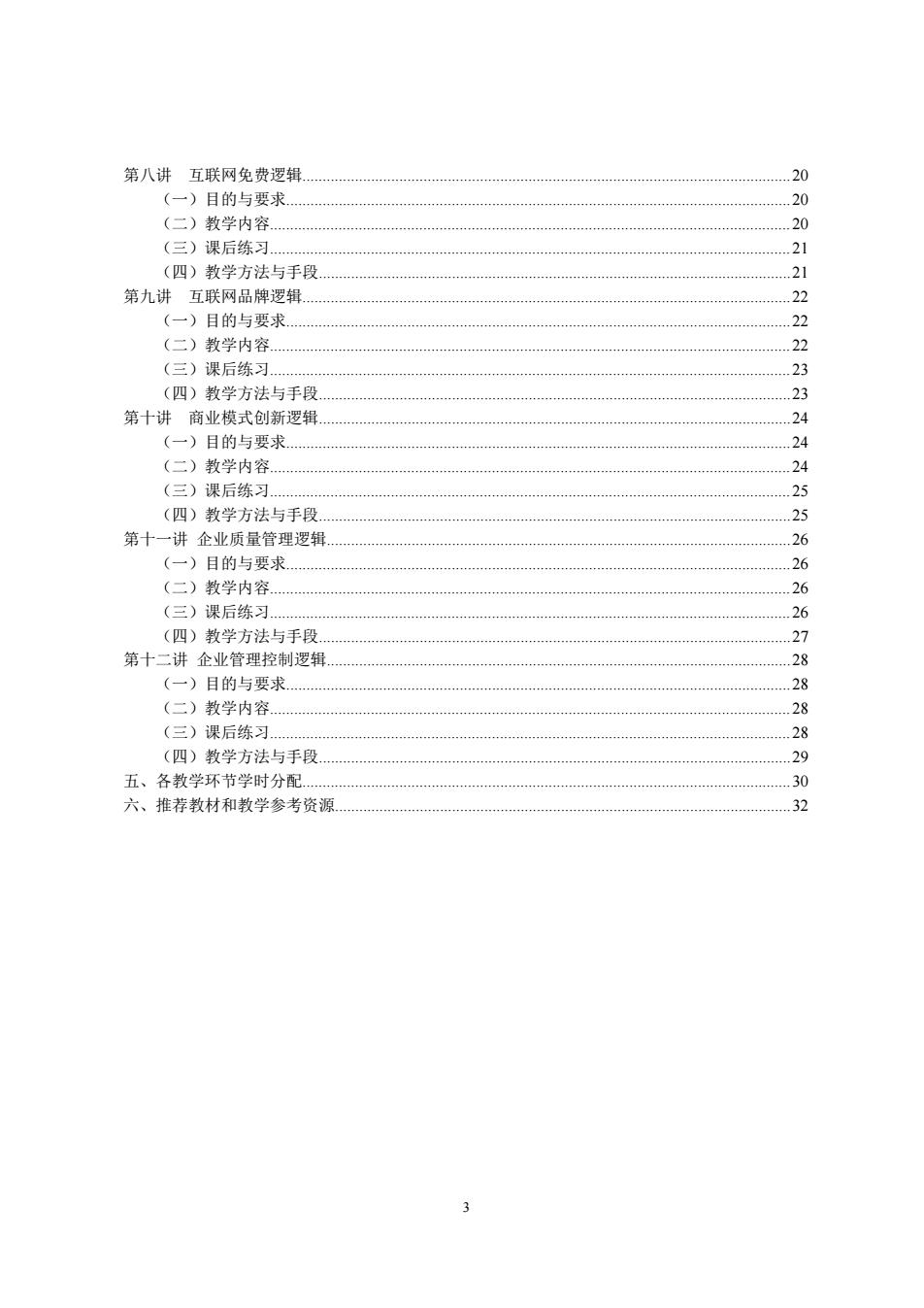
《企业逻辑与创新》教学大纲 2020年11月
《企业逻辑与创新》教学大纲 2020 年 11 月

目录 一、课程基本信息 4 二、课程简介 三、课程性质与教学目的 四数学内突及要求 第 逻辑、创新介绍 (一)目的与要求. (二)教学内容 .6 (三)课后练习 (四)教学方法与手段 第二讲 企业战略逻辑 (一)目的与要求 (二)教学内容 8 (二)课后练习 9 (四)教学方法与手段 0 第三讲企业技术创新逻辑 一)目的与要求 (二)教学内容 .10 (三)课后练习 11 (四)教学方法与手段 11 第四讲企业用人逻辑 (一)目的与要求 12 (二)教学内容 12 (三)课后练习 13 (四)教学方法与手段 13 第五讲企业团队罗纸 (一)目的与要求 (二)教学内容 (三)课后练习 (四)教学方法与手段 15 第六讲企业沟通逻辑 16 (一)目的与要求 (二)教学内容 16 (三)课后练习 (四)教学方法与手段 第七讲企业生存逻辑】 (一)目的与题求 教学内容 18 (三)课后练习. (四)教学方法与手段。 19
2 目录 一、课程基本信息....................................................................................................................................... 4 二、课程简介............................................................................................................................................... 4 三、课程性质与教学目的...........................................................................................................................5 四、教学内容及要求................................................................................................................................... 6 第一讲 逻辑、创新介绍...........................................................................................................................6 (一)目的与要求...............................................................................................................................6 (二)教学内容................................................................................................................................... 6 (三)课后练习................................................................................................................................... 7 (四)教学方法与手段.......................................................................................................................7 第二讲 企业战略逻辑...............................................................................................................................8 (一)目的与要求...............................................................................................................................8 (二)教学内容................................................................................................................................... 8 (三)课后练习................................................................................................................................... 9 (四)教学方法与手段.......................................................................................................................9 第三讲 企业技术创新逻辑.....................................................................................................................10 (一)目的与要求.............................................................................................................................10 (二)教学内容................................................................................................................................. 10 (三)课后练习................................................................................................................................. 11 (四)教学方法与手段..................................................................................................................... 11 第四讲 企业用人逻辑.............................................................................................................................12 (一)目的与要求.............................................................................................................................12 (二)教学内容................................................................................................................................. 12 (三)课后练习................................................................................................................................. 13 (四)教学方法与手段.....................................................................................................................13 第五讲 企业团队逻辑...............................................................................................................................14 (一)目的与要求.............................................................................................................................14 (二)教学内容................................................................................................................................. 14 (三)课后练习................................................................................................................................. 14 (四)教学方法与手段.....................................................................................................................15 第六讲 企业沟通逻辑.............................................................................................................................16 (一)目的与要求.............................................................................................................................16 (二)教学内容................................................................................................................................. 16 (三)课后练习................................................................................................................................. 17 (四)教学方法与手段.....................................................................................................................17 第七讲 企业生存逻辑.............................................................................................................................18 (一)目的与要求.............................................................................................................................18 (二)教学内容................................................................................................................................. 18 (三)课后练习................................................................................................................................. 19 (四)教学方法与手段.....................................................................................................................19

第八讲互联网免费逻辑 (一)目的与要求 0 (二)教学内容. 20 (三)课后练习 31 (四)教学方法与手段 第九讲互联网品牌逻辑 22 (一)目的与要求 (二)教学内容 (三)课后练习 3 (四)教学方法与手段 第十讲商业模式创新逻辑 2 (一)目的与要求 (一)教学内容 24 (三)课后练习 25 (四)教学方法与手段 3 第十 讲企业质量管理逻辑 26 (一)目的与要求. (二)教学内容 (三)课后练习. (四)教学方法与手段 第十二讲企业管理控制逻辑 2 -)目的与要求 22 (二)教学内容 (三)课后练习 28 (四)教学方法与手段 29 五、各教学环节学时分配 30 六、推荐教材和教学参考资源 3
3 第八讲 互联网免费逻辑.........................................................................................................................20 (一)目的与要求.............................................................................................................................20 (二)教学内容................................................................................................................................. 20 (三)课后练习................................................................................................................................. 21 (四)教学方法与手段.....................................................................................................................21 第九讲 互联网品牌逻辑.........................................................................................................................22 (一)目的与要求.............................................................................................................................22 (二)教学内容................................................................................................................................. 22 (三)课后练习................................................................................................................................. 23 (四)教学方法与手段.....................................................................................................................23 第十讲 商业模式创新逻辑.....................................................................................................................24 (一)目的与要求.............................................................................................................................24 (二)教学内容................................................................................................................................. 24 (三)课后练习................................................................................................................................. 25 (四)教学方法与手段.....................................................................................................................25 第十一讲 企业质量管理逻辑...................................................................................................................26 (一)目的与要求.............................................................................................................................26 (二)教学内容................................................................................................................................. 26 (三)课后练习................................................................................................................................. 26 (四)教学方法与手段.....................................................................................................................27 第十二讲 企业管理控制逻辑...................................................................................................................28 (一)目的与要求.............................................................................................................................28 (二)教学内容................................................................................................................................. 28 (三)课后练习................................................................................................................................. 28 (四)教学方法与手段.....................................................................................................................29 五、各教学环节学时分配.........................................................................................................................30 六、推荐教材和教学参考资源.................................................................................................................32

一、课程基本信息 课程代码:16219902 课程名称:企业逻辑与创新 英文名称:The logic and innovation of enterprise 课程类别:通识课程 学 时:32 学分:2 适用对象:适应各专业的学生。 考核方式:考查 二、课程简介 中文简介 本果程的主要思想是井授企业的罗辑,个业诵过创新为申多的顾客提供事好的而 客价值,把企业做强做大。强调逻辑思维和创新思维。注重培养学生的创新精神、企 业家精神和爱国主义精神等。讲授内容包括而不限于企业战略逻辑、企业技术创新逻 辑、企业用人逻辑、企业沟通逻辑、互联网免费逻辑、互联网品牌逻辑、互联网商业 创新逻辑等。通过本门课程的教学,使学生能够从逻辑、创新思维角度,对企业、对 管理的基本理论、基本原理和基本方法有较深入地思考,为进一步学习专业管理和从 事管理工作打下坚实基础。通过本课程中案例的分析,让学生了解企业生存、成功的 逻辑,从逻辑和创新角度分析和掌握相关的企业管理应用。 The main idea of this course is to teach the logic of the enterprise.which provides better customer value for more customers through innovation,and makes the enterprise stronger and stronger.This course emphasizes logical thinking and innovative thinking.This course content includes but not limited toenterprise strategic loic.enterprise technology innovation ogic logic of choose and employ persons. enterprise communication logic,the Internet free logic,Internet brand logic,Internet business innovation logic,etc.Through the teaching of this course,students wil,to the enterprise,the management of the basic theory.basic principle and basic methods have more in-depth understanding through the logic and creative thinking.for further studying management and working in the management to lay a solid foundation.Through the analysis of the cases in this course,students can understand the logic of enterprise survival and success,and analyze and master relevant enterprise management applications from the perspective of logic and innovation
4 一、课程基本信息 课程代码:16219902 课程名称:企业逻辑与创新 英文名称:The logic and innovation of enterprise 课程类别: 通识课程 学 时:32 学 分:2 适用对象: 适应各专业的学生。 考核方式:考查 二、课程简介 中文简介 本课程的主要思想是讲授企业的逻辑,企业通过创新为更多的顾客提供更好的顾 客价值,把企业做强做大。强调逻辑思维和创新思维。注重培养学生的创新精神、企 业家精神和爱国主义精神等。讲授内容包括而不限于企业战略逻辑、企业技术创新逻 辑、企业用人逻辑、企业沟通逻辑、互联网免费逻辑、互联网品牌逻辑、互联网商业 创新逻辑等。通过本门课程的教学,使学生能够从逻辑、创新思维角度,对企业、对 管理的基本理论、基本原理和基本方法有较深入地思考,为进一步学习专业管理和从 事管理工作打下坚实基础。通过本课程中案例的分析,让学生了解企业生存、成功的 逻辑,从逻辑和创新角度分析和掌握相关的企业管理应用。 The main idea of this course is to teach the logic of the enterprise, which provides better customer value for more customers through innovation, and makes the enterprise stronger and stronger. This course emphasizes logical thinking and innovative thinking. This course content includes but not limited to enterprise strategic logic, enterprise technology innovation logic, logic of choose and employ persons, enterprise communication logic, the Internet free logic, Internet brand logic, Internet business innovation logic, etc. Through the teaching of this course, students wil, to the enterprise, the management of the basic theory, basic principle and basic methods have more in-depth understanding through the logic and creative thinking, for further studying management and working in the management to lay a solid foundation. Through the analysis of the cases in this course, students can understand the logic of enterprise survival and success, and analyze and master relevant enterprise management applications from the perspective of logic and innovation

三、课程性质与教学目的 本课程是通识课程。面向全校选修课,授课面广,希望为学生在相关管理知识、 结合管理理论与实践的逻辑、创新思维能力等有所提高。 通过本门课程的教学,使学生能够较好地掌握管理的基本理论、基本原理和基本 方法,让学生了解企业生存、成功的逻辑,从逻辑和创新角度分析和掌握相关的企业 管理最基本的理论知识。在讲授、讨论和练习中培养学生的创新能力,也获得逻辑思 考能力的锻炼和提高。目前互联网发展迅速的环境里,帮助学生了解互联网企业等的 商业逻辑。提高学生市场导向下的分析问题、解决问题以及创新的能力
5 三、课程性质与教学目的 本课程是通识课程。 面向全校选修课,授课面广,希望为学生在相关管理知识、 结合管理理论与实践的逻辑、创新思维能力等有所提高。 通过本门课程的教学,使学生能够较好地掌握管理的基本理论、基本原理和基本 方法,让学生了解企业生存、成功的逻辑,从逻辑和创新角度分析和掌握相关的企业 管理最基本的理论知识。在讲授、讨论和练习中培养学生的创新能力,也获得逻辑思 考能力的锻炼和提高。目前互联网发展迅速的环境里,帮助学生了解互联网企业等的 商业逻辑。提高学生市场导向下的分析问题、解决问题以及创新的能力